Contents
The pheasant subfamily, which includes the species Common pheasant, is quite numerous. It has not only many genera, but also a lot of subspecies. Due to belonging to different genera, many varieties of pheasants do not interbreed. But when they say “pheasant” they usually mean the Asian species.
Asian look
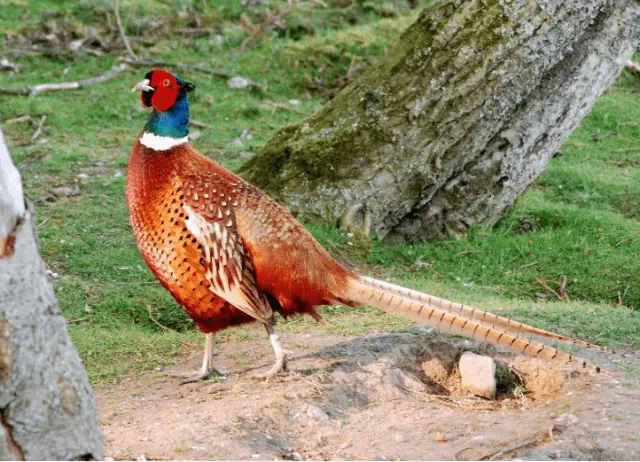
Another name for this species is the Caucasian pheasant. It was domesticated in the Asian part of the mainland, although today it is widely distributed in the wild. The bird received its name from the city of Phasis, located in Colchis (the eastern coast of the Black Sea). From this settlement, according to legend, the Argonauts brought these birds to the European part of the mainland. But, given the number of subspecies of the Common Pheasant, it spread itself. But on other continents, this species was introduced by man.
In total, this species has 32 subspecies. It is not clear whether they can be called breeds, since they developed without human intervention, but when bred in the household, these subspecies are usually simply called breeds.
The most common breeds of the Common Pheasant that are in Our Country are Caucasian, Manchurian and Romanian.
For this reason, the description of a hunting pheasant will vary depending on the subspecies. But often only an ornithologist is able to understand all the intricacies of plumage color. As an example, a photo of two varieties of the Common Pheasant: Phasianus colchicus principalis (Murghab), living in the Aral-Caspian lowland; below Southern Caucasus Pheasant (South Caucasian).
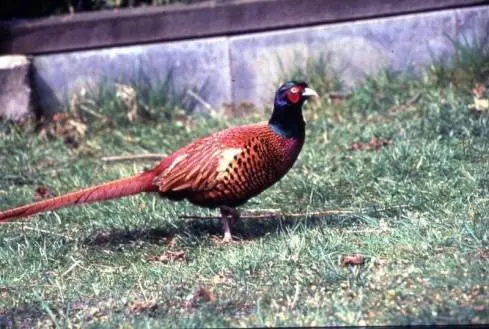
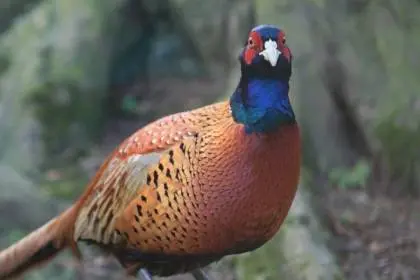
Female hunting pheasants of any subspecies are gray nondescript birds. It is very difficult to distinguish a pheasant of one subspecies from a female of another.
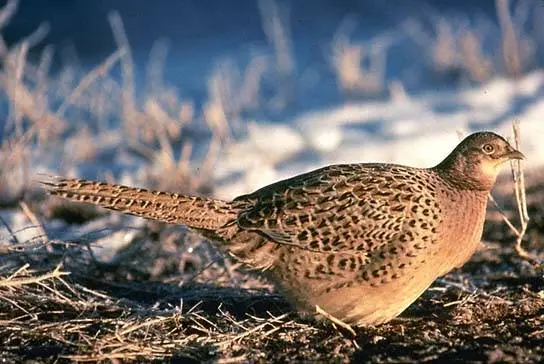
But in other cases, the color of different subspecies is very different from the typical North Caucasian.
Most suitable for home breeding “breeds” of the Common Pheasant. They are distinguished by a calmer disposition, as they have long been bred in captivity. In addition, it is the largest and most precocious, and, therefore, the most economically profitable species. Sexual maturity in “Asians” occurs already at the age of one year, while other species mature only by 2 years. Not all subspecies of the Hunting Pheasant look the same. To an inexperienced person, it may even seem that these are different species. Unscrupulous sellers take advantage of this moment, passing off various subspecies of the Hunter as separate breeds of pheasants, and even a photo with a description in this case does not help much, since the subspecies easily interbreed with each other.
On the personal farmsteads of pheasant breeders, two subspecies are most common: Caucasian and Romanian. The Romanian Pheasant is so different in appearance from other subspecies that beginners usually do not believe in the subspecies, considering it a breed. But pheasants, like peacocks, although they are bred in captivity, are not domesticated. Moreover, the “Hunting” and Romanian subspecies are often bred in order to release them on “free bread” in the fall and enable hunters to “hunt”.
The most common conditional “breeds” of pheasants in farms with photographs and names can be considered. The only inconvenience in keeping these birds is that they cannot be let out for free grazing, like chickens. Most likely they won’t come back.
“Domesticated”
The two most common and often mixed subspecies are Caucasian and Romanian. Although, if we compare a photo of a Caucasian “breed” pheasant with a Romanian one, then, at first glance, there is nothing in common between them.
Caucasian subspecies
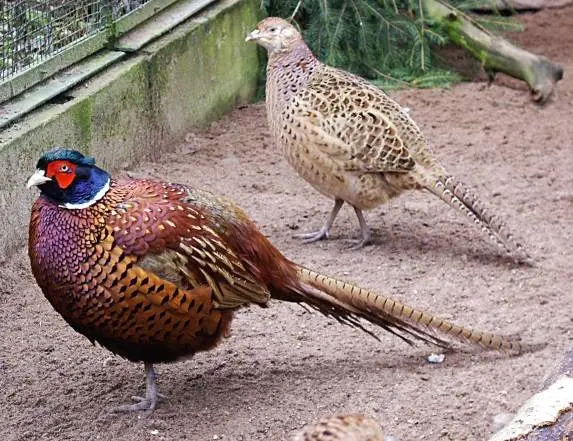
In the photo of pheasants, a heterosexual pair of birds. The male is a bright bird with colorful plumage in red-brown tones. The head is covered with black feathers with a strong purple tint. A thin white “collar” separates the black plumage from the red-brown. On the head of a sexually mature male there are patches of red bare skin. During the mating season, the “cheeks” begin to hang down even below the head.
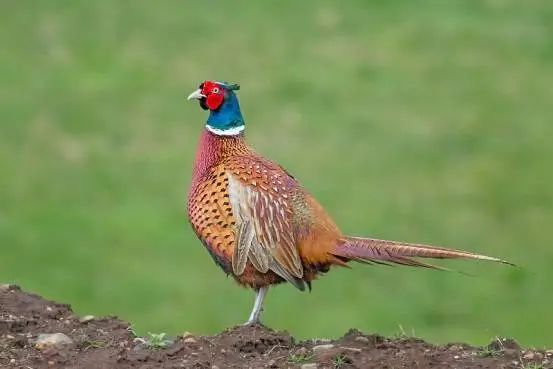
In addition, in a sexually mature male, tufts of feathers grow on top of the head, resembling horns sticking back. For the role of “ears” similar to those of the Eared Pheasants, these “horns” are not suitable. They do not stand out in color from the main plumage of the head and the direction of growth of feathers is somewhat different.
The color of females is the color of dried grass. This is an ideal disguise in the Asian steppes that burn out in summer, since only the female incubates the eggs.
Body length with tail up to 85 cm. Weight up to 2 kg. Females are smaller than males.
Romanian
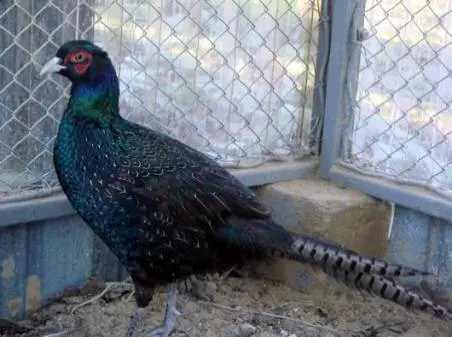
The description of a purebred Romanian pheasant is quite simple: the male has a solid black color with a strong emerald sheen. The females are considerably darker than the Caucasian subspecies. The plumage of the Romanian pheasants casts dark bronze.
The origin of the Romanian subspecies is not known for certain. It is believed that this is a hybrid of the Caucasian subspecies and the Japanese emerald pheasant. There is no consensus among ornithologists about Japanese. Some consider it a subspecies of Asiatic, others believe that it is a common superspecies with Asiatic. The latter opinion is based on the fact that sometimes there are hybrids of the Copper pheasant with the Japanese emerald. The photo below shows that the Japanese has little in common with the purebred Romanian. Perhaps Romanian is a spontaneous mutation of the Caucasian subspecies.

Romanian easily interbreed with the more common Caucasian, introducing additional confusion into the systematization of “breeds” by pheasant breeders. When hybridizing between these two subspecies, birds are obtained in color between the Romanian and Caucasian, as in the photo below.

The purity of the Romanian can be determined even in the chicken. The Caucasian chickens are motley, the Romanian ones are black with white breasts. If we compare the photo of a pheasant chicken of the Romanian “breed” with the Caucasian, then the difference is obvious.
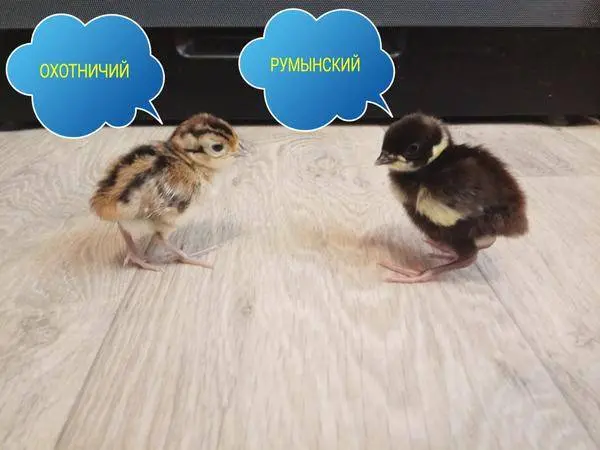
This difference persists until the juvenile molt. White spots in “Romanian” chickens can be of any size, but in an adult bird the color is solid.

The size and productivity of the “Romanians” are the same as those of the Caucasians. Therefore, in terms of productive breeding, there is no difference between them. The same situation is with other “breeds” of the Asian species.
Manchurian
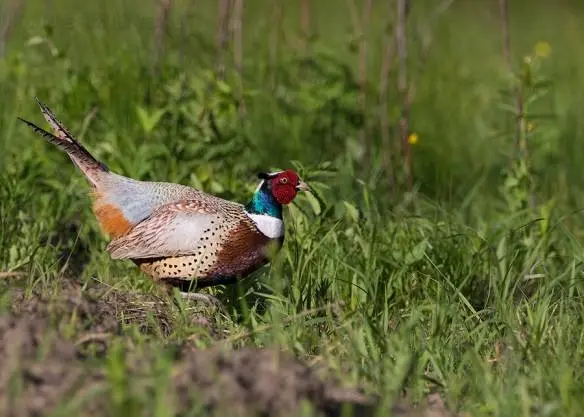
As you can see in the photo, the Manchurian subspecies of the Common pheasant is lighter and has almost no “redness” in the plumage. Back with gray plumage, orange feathers on the belly. The body is variegated beige. The female Manchurian even in the photo still needs to be looked for.
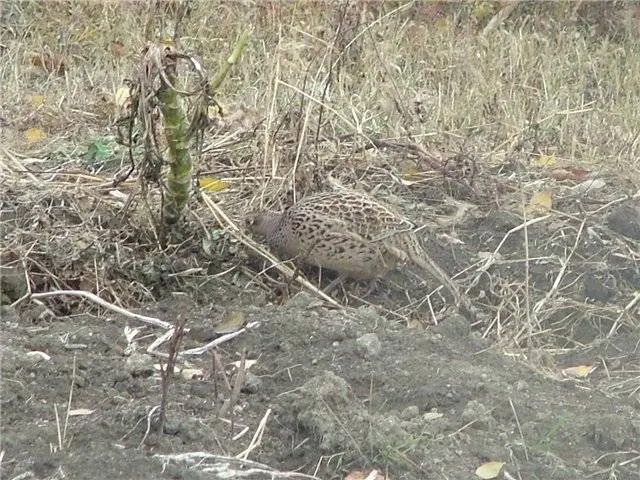
With plumage, it completely merges with withered grass. The color of the Manchurian pheasant is quite light.
On the video purebred Romanian and Hunting phase:
White
This is the only option that, with some stretch, can be called a breed. But in fact it is a mutation. In nature, white individuals usually die, but a person can afford to fix such a color. If there is no pair for the white pheasant, you can use the usual color Hunting individual.
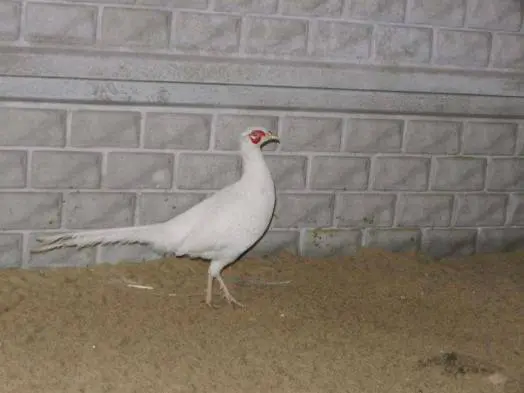
These are the main “breeds” that are usually bred in private backyards for meat and eggs. You can add others if you wish. Man is an omnivore and can eat any bird. Therefore, theoretically, not only subspecies of the Common pheasant, but also more exotic and vibrant species can be bred for meat.
Decorative
Several genera of these birds fall into the category of decorative birds at once, of which one, strictly speaking, is not even a pheasant. In addition to Okhotnichy, representatives of other pheasant genera are also found in the enclosures of pheasant breeders:
- Collar;
- eared;
- stripe-tailed;
- Lofurs.
All these birds from the pheasant family, photos and descriptions of which are presented below, can theoretically be bred for meat. In practice, the cost of these pheasants and the timing of their growth, as well as the difficulties in breeding, make these species completely “inedible”. Few people will raise their hand to send a very expensive bird into the soup.
collared
This genus got its name from the plumage on the neck, reminiscent of a luxurious medieval collar. The genus includes only two species, and both are found in the enclosures of amateur pheasant breeders.
Gold
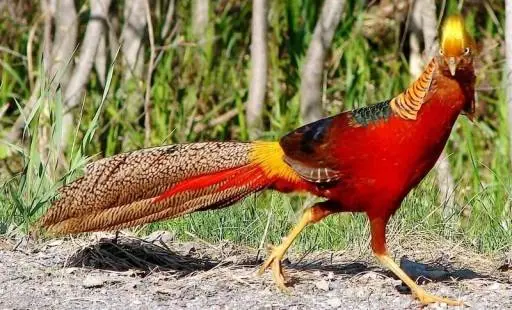
Golden or Golden Pheasant is a native of western China. Belongs to the genus Vorotnichkov and does not interbreed with Hunting breeds of pheasants. They tried to acclimatize it in Europe, but the birds mostly died in winter from the cold. Small semi-wild populations exist in Great Britain and Central Europe. But it is very difficult to see these cautious birds in natural conditions. Therefore, most people have to admire the Golden Pheasant in a photo or in a zoo.
In China, this species is bred in captivity for its beautiful feathers, and wild members of the species are also hunted. Although the total size of the Chinese population is unknown, this species is not threatened with extinction. Today, the wild population of these birds lives in the southern part of the Trans-Baikal region of the Federation and in Eastern Mongolia. In the UK, the population has no more than 1000 pairs.
Females, like all members of this family, are very modest.
Photo of a pair of golden pheasant birds.
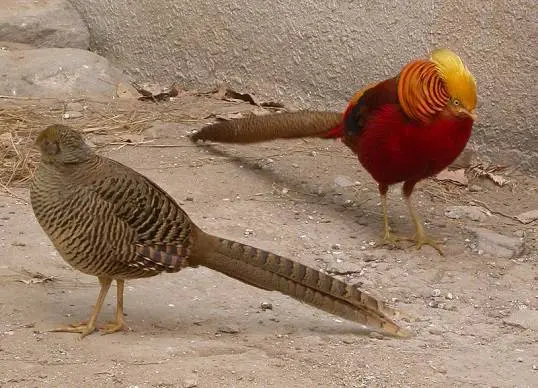
The meat of the Golden Pheasant is also edible, but compared to the Hunting species of pheasants, it is a very small bird. There is no point in raising Goldens for meat in Europe. Many hobbyists keep them as ornamental birds.
Thanks to the work of amateurs, color variations of the Golden Pheasant have also been bred. In particular, golden yellow.
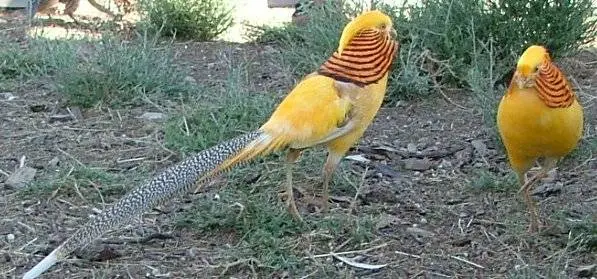
Diamond

Another representative of the Vorotnichkov family, the Diamond Pheasant, also comes from China. At home, he lives in bamboo forests, preferring mountain slopes. It was exported to the UK, where it prefers to settle in coniferous forests with trees no more than 30 years old.
The bird is very secretive and prefers to hide under the lower branches of fir trees. A modestly colored female Diamond Pheasant is difficult to see even in the photo among the vegetation. Even taking into account the fact that the photographer placed it in the center of the frame.
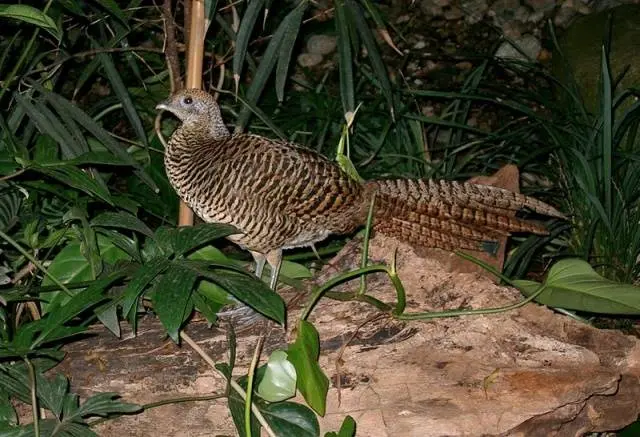
Compared to the brightly colored males, the pheasants present a striking contrast.
The diamond pheasant also does not interbreed with other species of these birds. It is bred as an ornamental bird. For productive breeding, this type of interest is not. There are very few of them in Our Country, but there are lovers who keep them to decorate the poultry yard.
eared
This genus contains 4 species. In the photo, by the appearance of pheasants with “ears”, it may seem that these are just different breeds or even different colors of the same breed of birds. In fact, these are 4 different species, the ranges of which in nature do not even intersect. Eared pheasants can be:
- blue;
- brown;
- White;
- Tibetan.
These birds bear little resemblance to the usual hunting birds. Most of all they resemble a guinea fowl. The common name of the genus “Eared” pheasants received for the characteristic bunches of feathers sticking back on their heads.
But the difference between Eared and Ordinary is that in Eared, tufts of feathers not only stick out backwards, but continue the characteristic white stripe running from the base of the beak to the back of the head.
The main feature of Eared Pheasants is the almost complete absence of sexual dimorphism in these birds. In these birds, it is impossible to distinguish a female pheasant from a male either in the photo or “live” until the mating season begins.
Breeding Eared Pheasants for meat is economically unprofitable, since they reach puberty only at 2 years old, and the number of eggs is not large.
Blue
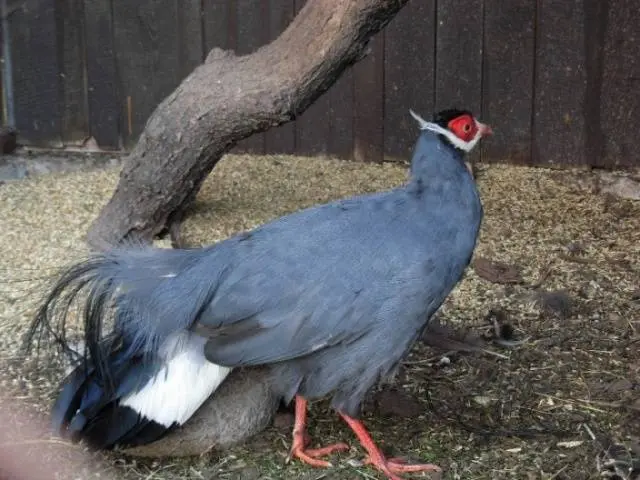
This is the most numerous species of the genus Eared. This species can be found on sale in Our Country. Since the tails of representatives of this genus are short, the length of the bird is indicated less than in other long-tailed species. So the length of the Blue-eared is only 96 cm. The plumage on the head is black. Red bare skin around yellow eyes. A strip of white feathers passes under the bare skin, turning into “ears”. The tail is loose and short. The species feeds mainly on berries and plant foods.
Brown
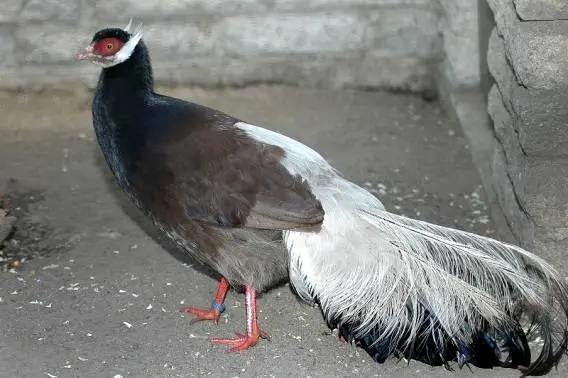
This is the rarest species of all Eared Pheasants. It is in the Red Book, so it is unlikely to be found on free sale. Accordingly, the data is for informational purposes only. Body size up to 100 cm. Almost the entire body is brown in color. A white stripe, turning into “ears”, covers the head, passing under the beak and bare skin. On the lower back the plumage is white. The upper tail feathers are also white. It feeds on plant foods.
White
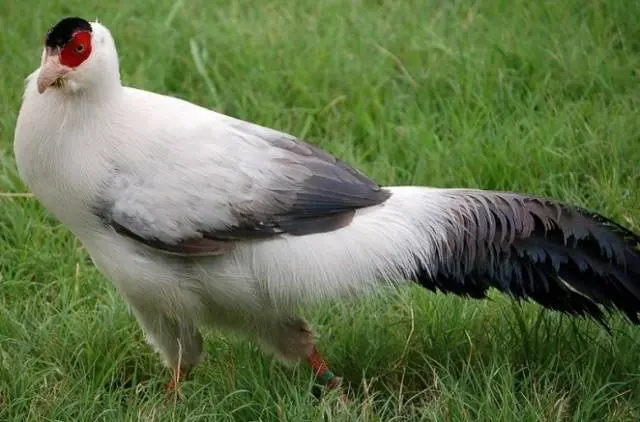
The species lives in the highlands on the border with eternal snows. Hence such unmasking, at first glance, color. In fact, in an area where black stones stick out of the snow, the bird’s coloration is ideal for camouflage. The inhabitants of the Himalayas call it “Shagga”, that is, “Snow Bird”.
The white-eared has two subspecies, outwardly differing in the color of the plumage on the wings. The Sichuan subspecies has dark gray or purple wings, while the Yunnan subspecies have black wings.
Juveniles cannot be distinguished by sex, but in adults, the male is almost twice as heavy as the female. The rooster weighs an average of 2,5 kg, the average weight of the female is 1,8 kg.
This species has a good ability to fly, which must be taken into account when keeping them at home.
Tibetan

The smallest representative of the genus Eared Pheasants. Its body length is 75-85 cm. The name directly indicates the habitat. In addition to Tibet, it is found in northern India and northern Bhutan. Prefers river valleys and grassy slopes of ravines in deciduous and coniferous forests. Usually found between 3 and 5 meters above sea level. Due to habitat destruction, today it is an endangered species.
Variegated
The genus of motley pheasants includes 5 species:
- Reeves/Royal/Motley Chinese;
- Elliott;
- Copper;
- Mikado;
- Mrs Hume.
All of them are inhabitants of the Eastern part of Eurasia. Copper is endemic to Japan, and Mikado is endemic to Taiwan.
variegated chinese
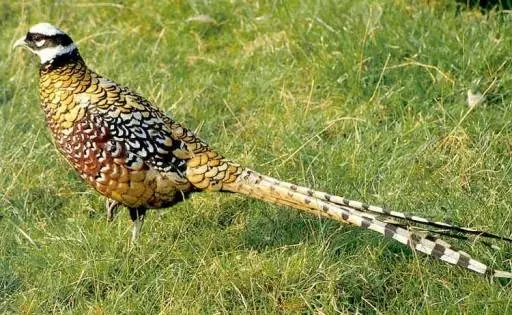
The more famous and common name for this elegant bird is the Royal Pheasant. Belongs to the third genus of pheasants – Motley pheasants. It lives in the foothills of Central and Northeast China. This is one of the largest representatives of the pheasant. In size, it is equal to the Common Pheasant. The weight of males reaches 1,5 kg. Females are a little short of a kilogram and weigh 950 g.
The motley plumage of females, being more elegant than in other species, makes them completely invisible against the background of burnt grass. Even in the photo, the female of the Royal pheasant is difficult to notice at a cursory glance.
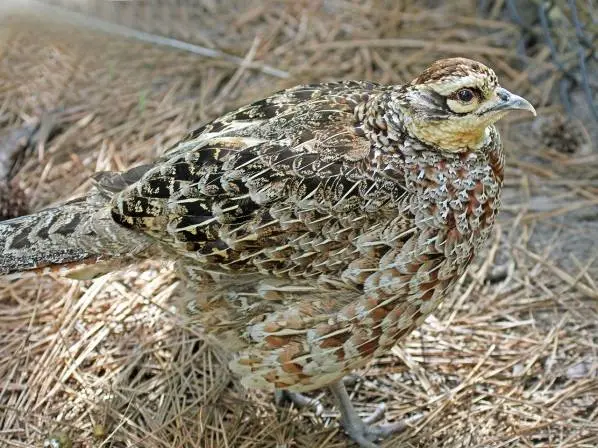
Copper

In the photo, the female Romanian pheasant may seem very similar to the male Copper. This is perhaps the most “modest” species of all pheasants. But if the Romanian female has a dark bronze feather all over the body, then the Copper male has a color with a large amount of red on the head and neck, and a two-color feather on the stomach: red areas alternate with gray. A definite difference in a mature rooster is red bare skin around the eyes.
Elliot

This bird is unlikely to be confused with another species. The conspicuous white neck and motley back immediately give out belonging to the Elliot pheasant. With a closer look, a white belly will only confirm the first impression. This species lives in East China.
The bird is small compared to the rest. The total length is 80 cm, of which more than half falls on the tail. The weight of the male is up to 1,3 kg, the pheasant weighs up to 0,9 kg.
The body length of a pheasant is 50 cm. But if the rooster has a tail 42-47 cm long, then the female has 17-19,5 cm.
Elliot’s pheasant is bred in captivity. Since the birds are very secretive, all data on their mating behavior are obtained from observations of individuals kept in captivity.
Mikado

Endemic about. Taiwan and its unofficial symbol. The bird is small. Together with the tail, it can be from 47 to 70 cm. It is endangered and listed in the World Red Book.
Mrs. Hume (Yuma)

In color, this species simultaneously resembles the Manchurian subspecies of the Common pheasant and Elliot’s pheasant. The bird is quite large. Length 90 cm. The name was given in honor of the wife of the British naturalist Allan Hume.
Lives in Southeast Asia. The species is very rare and is in the Red Book.
lofurs
The name “pheasant” for these species is erroneous, although it is difficult to distinguish these from real pheasants in the photo. Lofurs are in the same family as the genus Real and Collared pheasants. The second name of the genus Lofur is Chicken Pheasants. They have the same food habits. Behaviors and marriage rites are similar. Therefore, lofur is easily confused with real pheasants. But these birds cannot interbreed.
Silver
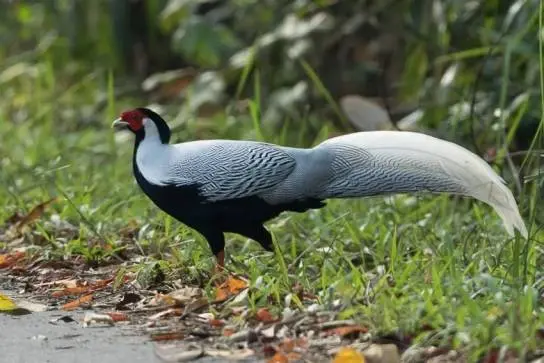
In fact, the Silver Pheasant is a lofur from the genus Lofur. But this genus also belongs to the pheasant family. Outwardly, the Silver Pheasant differs from real pheasants in its longer legs and fluffy sickle-shaped tail. Metatarsals of the Silver Pheasant, as seen in the photo, are bright red. Another difference between lofurs and real hunting pheasants is also visible in the photo: a bunch of feathers directed backwards on the head.

On the feathers of the back, neck and tail, small stripes of white and black alternate. Sometimes, as in the photo above, the “silver” of a pheasant can give way to a greenish plumage.
Young pheasants do not have “silver”. Their back plumage is gray-black.
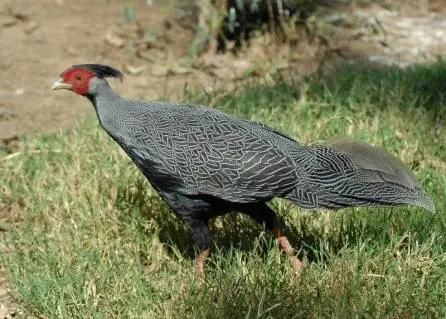
In contrast to the bright black and white male, the female silver pheasant in the photo can only be guessed by the silhouette and bright red legs.
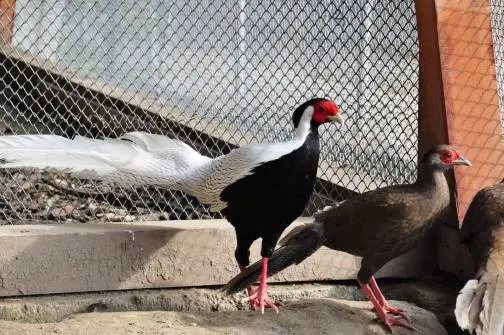
By itself, the Silver Pheasant is a medium-sized bird. But the length of the tail is usually added to the size of the birds and data is indicated from the tip of the beak to the tip of the tail. Therefore, with relatively equal body sizes, the length of the male is almost twice as large. The male lofur reaches 90-127 cm in length, the female only 55-68. The weight of males varies from 1,3 to 2 kg, females weigh about 1 kg.
black lofur
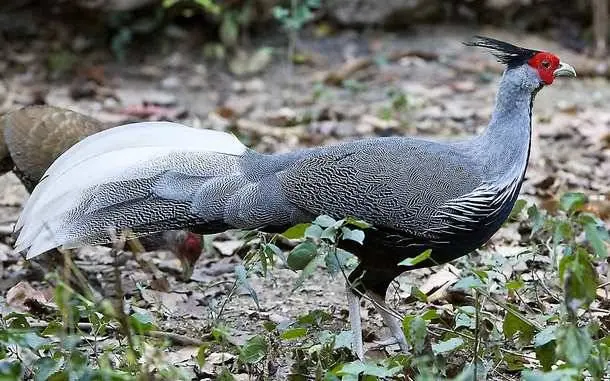
The second name is the Nepalese pheasant. According to the photo and description, this variety of chicken pheasant can be confused with the young Silver. But the color of the feathers on the back and neck of the Black lofur is not white, like that of the Silver, but more like the feathers of a blue guinea fowl.
Lives in the mountains of Asia. The bird is relatively small, weight 0,6-1,1 kg. The length of the male is up to 74 cm, females – up to 60 cm.
Breeding
All species and breeds of pheasants breed very well in captivity. But to get offspring from these birds, an incubator is needed. In order for the pheasant to sit down to incubate her eggs herself, she needs to create conditions in the aviary similar to natural ones. This means a large area of the enclosure and many shelters from bushes and houses in the territory. Pheasants are secretive birds. Unlike domestic chickens, they are poorly satisfied with nest boxes that are easily accessible to strangers.
The collected eggs are placed in an incubator and the chicks hatch in the same way as chickens. The period of incubation of eggs in different species is from 24 to 32 days.
Conclusion
As a productive bird, the pheasant is not economically viable. But if there is a need to grow it for meat or for hunting, then it does not matter much whether the “pure” subspecies is slaughtered or released. A photo of different “breeds” of pheasants is important only if there is a need to breed a subspecies “clean”. And photographs are needed only to get an idea of what one or another subspecies of the Common Pheasant looks like.









